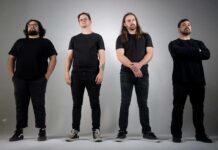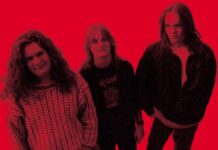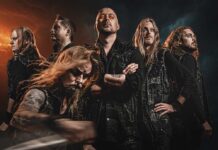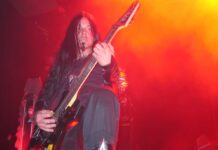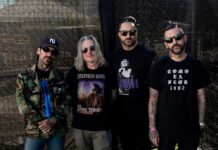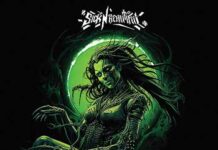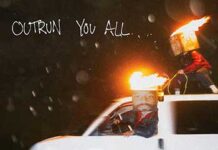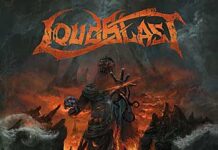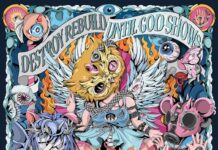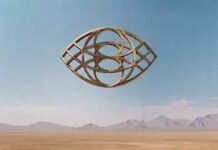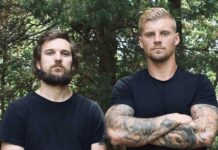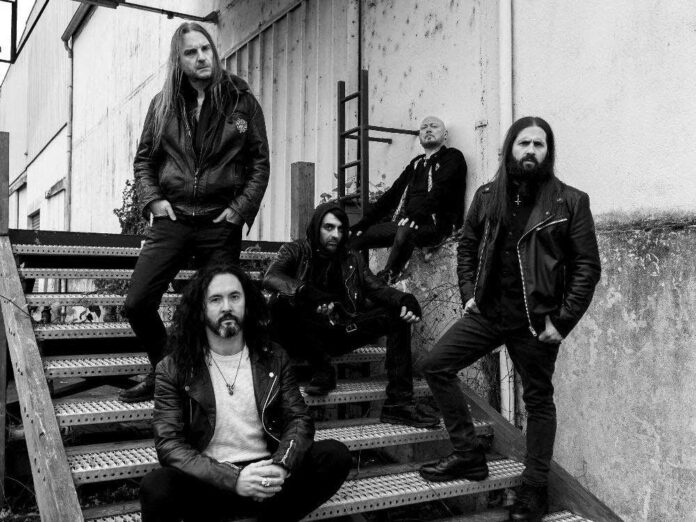
INTERVIEW WITH FRÉDÉRIC LECLERCQ BY JILLIAN DRACHMAN
“Grief is like a shadow that follows you everywhere, time is just a pint of salt poured on a wound that oozes and never heals.” ~ Maxime Taccardi
Sinsaenum has returned with a phenomenal third full-length triumph, which is bound to leave listeners speechless: In Devastation punishes by virtue of its beauty and brutality. Sinsaenum stands as the project of Frédéric Leclercq of Kreator, Loudblast, formerly DragonForce, and a slew of other amazing bands. Although Sinsaenum is known as a supergroup, Leclercq explains, “I don’t like the name supergroup because, to me, it implies something that you do on the side of your band for fun, whereas I always consider Sinsaenum a band that’s here to last.”
Sinsaenum proves a timeless beast to be feared, as reflected by the intensity, artistry, and profundity of In Devastation. Nevertheless, there is simply no maneuvering around the fact that Sinsaenum is composed of many of metal’s greatest talents: Mayhem’s Attila Csihar, Dååth’s Sean Zatorsky, Loudblast’s Stéphane Buriez, Seth’s Heimoth, and Portuguese skin-pounder André Joyzi—the drum tech for Sinsaenum’s late Joey Jordison, also remembered for Slipknot and Murderdolls.
Regarding In Devastation, Leclercq confirms, “I wrote the majority of the music, if not all.” As the band leader, Leclercq is “the one making sure that everything falls into place.” However, Leclercq clarifies, “On the previous album [Repulsion for Humanity, 2018], Joey, for example, wrote a musical part for the song ‘Repulsion for Humanity,’ and he wrote the lyrics together with Sean and I for ‘Final Resolve’ and ‘Nuit Noire.’ I believe everybody contributed a bit more because we were short on time. The first album [Echoes of the Tortured] came out in 2016. Then, we did an EP [Ashes] in 2017, and we wanted to have a second album out so we could go on tour.”
“After Repulsion for Humanity, I was exhausted, so I would take my time for number three. In the meantime, I had to write new songs for DragonForce and my melodic band Amahiru, and I joined Kreator. That was 2019. Then, in 2020, we started working on new material for Kreator. Then, I lost my father. That left me dry. And then, Joey passed away not even a year after. That left me dry, too. And then, we decided that we would carry on, and that the album would be a tribute to them, so it had to be good. We didn’t want to rush things.” Because Kreator’s Hate Über Alles would not be unleashed until 2022, Leclercq realized that he had extra time to craft the best offering possible for Sinsaenum, given that the circumstances wouldn’t be optimal to release their third record until his schedule would allow him to make plans in support of it.

“And as for the lyrics, we had external contributions from people I have been working with in Loudblast and Amahiru, like Mike Heller, Amahiru’s drummer. I thought it would be interesting to experiment with some external people, seeing as the rest is very much done in a family mode. And then, we could go back and forth.”
“We definitely wanted to experiment more on the vocal side of things with Sean. I knew he was capable of clean singing, and he’s got a great voice. We wanted to incorporate that into ‘Obsolete and Broken,’ for example. I’m also singing softly because it felt like the middle of the song was more of a peaceful moment. I wanted to have dynamics in that song and thought, ‘Why not add a sitar?!’ Because it felt almost like a Spinal Tap ‘Listen to the Flower People’ sort of vibe.”
Regarding his bandmates’ execution of his vision, Leclercq tells us, “They understand perfectly what’s to be done. And also, I give them freedom because you need to let everyone add their color.” Leclercq notes that he was often surprised by the power of their contributions, “Sean’s voice on ‘Last Goodbye’ caught me off guard because he’s singing with such emotion, and it was even better than what I expected. The same happened with some of the solos that Stéphane came up with and the drumming. So, those are the types of things that amazed me—they weren’t parts that weren’t written, but things that were done with passion and in a beautiful way.”
On the topic of “Last Goodbye,” Leclercq further shares, “Attila tried out laughter and cries for the song because we wanted to experiment with that middle section, where the cello is right now. But before, there was no cello, and it sounded a little empty.” Mr. Csihar’s astoundingly disturbing laughter and cries ended up concluding the album on “The Red Wall.” Leclercq reveals, “There’s much more! I have two different takes of him laughing, and I think those are mixed now. But, yeah, I have a long version.”
Zatorsky and Csihar, whom Leclercq describes as “the man in the shadows” in a sense, constitute the ideal vocal pairing. “It’s a luxury to have those two amazing singers and be able to use them at their best.” Leclercq expresses that Csihar wished to be directed this time around, “‘Tell me exactly what you have in mind, and I’ll do it.’ So, I took the lyrics and just highlighted. ‘Okay, could you do this one with that voice and that there?’ But even then, I couldn’t really make up my mind. And so, we tried different things out. There were a lot of layers of vocals. I knew that I wanted him on the chorus of ‘In Devastation’ and ‘This Wretched World.’ It felt like his voice would be a perfect fit for those parts, and it gives a different dimension to the songs.”
As for drums, Leclercq told Joyzi, Sinsaenum’s newest member, “Take your time to work on this.” Leclercq emphasizes, “To me, it was important to work with someone who’s part of the family. I actually asked him to join the band around the time he wanted to quit. He was like, ‘I’m done with the music business.’ I wasn’t aware of that, and I just hit him up.”
Leclercq, of course, enjoyed teaming up with producer Lasse Lammert for In Devastation. As a repeat accomplice of Japan’s legendary Sigh (whose very own Mirai Kawashima and Dr. Mikannibal guested on Echoes of the Tortured), Leclercq met Lammert while contributing to I Saw the World’s End — Hangman’s Hymn MMXXV (2025). “I really liked the way he worked with Sigh, and then I checked his previous works. I was like, ‘Wow, okay, he’s been able to do this and that, and I like what I hear.’”
Their collaboration on In Devastation “took a long-long time.” While other projects emerged that similarly required Lammert’s attention, Leclercq remained busy as well. “I went away on tour and then was able to revisit the material at least twice during the process. It was great to be able to come back to all the layers and try out new ideas, the same with the samplers and the electronic elements—we had way more. But then, you need to make a selection. There’s probably as much unused as what’s been used, so it was a real puzzle. Lasse was sending me clips, and he was just like, ‘Look, you’ve got this and that,’ which I had forgotten about. I was like, ‘Oh, that’s right. Yeah, I’ve done this, and Sean’s done that, and they would not work together.’” Leclercq continues, “A big part of the result is the sonic landscape that Lasse created. He gave the right space for each element. I think we have a good combination of my crazy, or not so crazy, ideas and his ability to translate that into something that people can appreciate.” Leclercq is credited as a producer as well.
Although Sinsaenum is typically branded as a blackened death metal act, In Devastation transcends categories due to its innovation. Leclercq describes Sinsaenum’s evolution thus, “The first album was a love letter to the genre of death metal. The second one had more groove metal influences, which you can probably still find in the new one. I had some touches of Pantera because I always loved the band, and I just felt like there should be a natural evolution of our sound. And for this one, I had nothing to prove. I was like, ‘I’m just going to do what I want.’ So, there’s a bit of everything. For example, in ‘This Wretched World,’ the solo section has a lot of different parts and melodies. But it all still sounds like it’s the same band.”
Leclercq adds, “One of the points was for Sinsaenum to find its own path, especially considering that Loudblast is also death metal. I didn’t see the point of going into the same territory, so that probably led me to where the band should go in terms of songwriting and having the right amount of harshness. Sinsaenum is cleaner than, say, Loudblast and more evil than Kreator.”
Speaking of evil, In Devastation over-brims with a sinister magic, of which the vast majority of black metal bands can only dream. Nevertheless, Leclercq reflects, “I think Ashes is the release with the most touches of black metal.” For the cover and additional art accompanying that EP, Sinsaenum enlisted the outstanding black metal musician and internationally revered visual artist Maxime Taccardi. Among the stunning pieces Taccardi created for Sinsaenum is a band portrait, Jordison’s likeness included, painted in his own blood. Leclercq comments, “Maxime’s a great artist, and, to me, it made sense to call him back for ‘Last Goodbye’ because it’s a very emotional song, and I know he lost both of his parents as well.”
Jordison actually played live with the Norwegian black metal stalwarts Satyricon, and Leclercq recalls that Jordison enjoyed the French black metal outfit Anorexia Nervosa. Leclercq and Jordison would discuss death metal groups like Morbid Angel and Suffocation, though their conversations even touched upon the mainstream corruptor of souls behind “Only the Good Die Young,” Billy Joel.
Leclercq relays the story of how he first connected with Jordison, “It was at a festival in the Netherlands, I think. It was also the first time I met Chuck Billy [of Testament], actually. We had just played our show, or we were about to play our show. Sam from DragonForce and I were drunk. Joey was there, and we went up to him and said, ‘Yeah, dude, Joey Jordison!’ And he was like, ‘Hey guys, how are you doing?’ We said, ‘Yeah, you’re cool. You’re a maggot!’ And he was like, ‘Yeah, that’s what we call our fans.’ And we’re just like, ‘No-no, you’re a maggot.’ And he was like, ‘Hey?!’ We thought the name was funny, especially me being French, and we said it in a friendly, not evil, way. Then, we just went and annoyed someone else.”
“The year after, we did the Rockstar Energy Mayhem Fest in the USA. Slipknot is headlining, and I’m friends with Disturbed as well. So, it’s like, ‘Oh, this is going to be a cool tour.’ On the first evening, I was talking to someone who said, ‘Hey, nice to meet you. I’m Paul. I’m the bass player of Slipknot.’ ‘No, you’re not.’ And he’s like, ‘Yeah, I am.’ I’m like, ‘Well, how do I know? Because, with the masks, I have no idea.’ And he responds, ‘How about if I take you backstage, and then you’ll believe me?!’ I say, ‘Yeah, why not?!’ And then, he took me there. I’m like, ‘Okay, fair enough.’ We get a drink, and there’s a room, and Joey’s in there, and he’s just like, ‘Hey, you, come here.’ I had forgotten about the thing, so I’m just walking in. ‘Hey, how are you doing?’ He’s like, ‘Yeah-yeah, I remember you. You called me a maggot.’ And I’m like, ‘What?’ And he’s like, ‘Nobody fucks with Slipknot.’”
In conclusion, Leclercq states, “I hope that listeners enjoy the music as much as I enjoy making music because, at the end of the day, that’s what I’m here for.” In addition, we urge readers to experience the upcoming documentary Kreator—Hate & Hope, featuring Leclercq, which will celebrate its theatrical release on September 4th.

